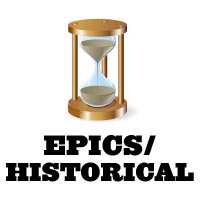Epics of Royalty Figures:
One of the most common themes or topics of epics are royalty,
kings, or leading personalities or figures from the times. (See adventure
films for epics related to the King Arthur tale.) Royals have been
the subject of epics such as the following:
- French director Abel Gance's phenomenal four hour long Napoleon (1927) about the legendary military hero
 Oscar-winning
actor Charles Laughton as the infamous king in Alexander Korda's The
Private Life of Henry VIII (1933) with doomed wife Jane Seymour (Elsa
Lanchester) and Anne Boleyn (Merle Oberon) Oscar-winning
actor Charles Laughton as the infamous king in Alexander Korda's The
Private Life of Henry VIII (1933) with doomed wife Jane Seymour (Elsa
Lanchester) and Anne Boleyn (Merle Oberon)- two versions of the life of 18th century Russia's Catherine
the Great in the same year: Josef von Sternberg's mostly fictional account The Scarlet Empress (1934) - with Marlene Dietrich, and Paul Czinner's Catherine the Great (1934) with Elisabeth Bergner
- Rouben Mamoulian's Queen Christina
(1933) with Greta Garbo in the lead role as the 17th century Swedish
queen
- Michael Curtiz' The Private Lives of Elizabeth and Essex
(1939) with Bette Davis as the Queen and Errol Flynn as Robert Devereaux,
the Earl of Essex
- Laurence Olivier's Henry V (1944), a Shakespearean
adaptation about the King of England who battled the French over Normandy;
also director/star Kenneth Branagh's version in the late 80s, Henry V
(1989)
- Sergei Eisenstein's Ivan the Terrible, Part I (1945,
Soviet Union) about
the heroic 16th century Russian Czar Ivan IV
- MGM's Techni-colored adventure swashbuckler epic Ivanhoe
(1952) with Robert Taylor in the title role
- Anatole Litvak's Anastasia (1956) about the early
20th century story of Princess Anastasia (Ingrid Bergman), the daughter
of the late Czar Nicholas - this film also marked actress Bergman's return
to Hollywood after a period of exile with a Best Actress Oscar
- Peter Glenville's costly UK historical costume drama Becket
(1964) with Richard Burton and Peter O'Toole in the lead roles as Thomas
Becket (the Archbishop of Canterbury) and King Henry II
- Best Picture-winning director Fred Zinnemann's A Man
for All Seasons (1966) about the gripping conflict between idealistic
Catholic Sir Thomas More (Paul Scofield) and King Henry VIII (Robert Shaw)
over the king's decision to break from the Roman Catholic Church to form
his own Church of England (Anglican/Episcopalian), so he could divorce his
first wife and marry Anne Boleyn, since his first wife failed to produce
a male heir to the throne
- Anthony Harvey's UK film The Lion in Winter (1968),
a superb character study of Britain's 12th century King Henry II (Peter
O'Toole) and his estranged-exiled wife and Queen Eleanor of Aquitaine (Katharine
Hepburn in an Oscar-winning role)
- Charles Jarrott's UK film Anne of the Thousand Days
(1969), an adaptation of Maxwell Anderson's 1948 stage play, in which
Richard Burton as England's King Henry VIII casts off Catharine of Aragon
to marry Anne Boleyn (Genevieve Bujold) against the church's wishes, but
then executes his love under the pressures of court politics when she proves
to be barren and cannot produce a male heir
- Franklin Schaffner's beautiful-to-behold Nicholas and
Alexandra (1971) chronicles the last 14 years of the rule of the last
of the Russian Romanovs - Russian Czar Nicholas II (Michael Jayston) and
his wife Czarina Alexandra (Janet Suzman) - up to the Bolshevik Revolution
in 1917 and their execution a year later [Norman Jewison's epic musical
of the same year, Fiddler on the Roof (1971), was also set at the
turn-of-the-20th century, pre-revolutionary Russia, in the Ukranian
ghetto village of Anatevka]
- Indian director Shekhar Kapur's Elizabeth (1998) with break-out star Cate Blanchett as the pale-faced 16th century Virgin
Queen
The Great Epic Director - David Lean:
 British
director David Lean has produced some of the best historical epics of all-time
- films that focused on a major romance, character, or swashbuckling adventure
in the foreground, with the historical events serving as a colorful backdrop.
His films had a major effect upon the British film industry for years to come.
Lean's epic masterpieces included: British
director David Lean has produced some of the best historical epics of all-time
- films that focused on a major romance, character, or swashbuckling adventure
in the foreground, with the historical events serving as a colorful backdrop.
His films had a major effect upon the British film industry for years to come.
Lean's epic masterpieces included:
- the anti-war epic drama of the struggle of wills between
British POW Col. Nicholson (Alec Guinness) and Japanese Colonel Saito in The Bridge on the River Kwai (1957) during the construction of
a rail bridge to link Bangkok and Rangoon
- Best Picture-winning Lawrence of Arabia (1962) with Peter O'Toole as the legendary
Arab and desert-loving British officer T. E. Lawrence during World War I
- an adaptation of Russian writer Boris Pasternak's novel, Doctor Zhivago (1965), about a war-time romance during the snow-swept
Russian Revolution
- and finally Lean's swan song, the brilliant Passage
to India (1984), based on E. M. Forster's 1924 novel of the romantic
adventures of a young Englishwoman in the East
The Merchant-Ivory Period Films:
The exquisite, beautifully-composed, best-known period
films of the triumvirate (producer Ismail Merchant, director/screenwriter
James Ivory, and novelist Prawer Jhabvala) have often used historical settings
as backdrops for their well-crafted dramas, often taken from the writings
of E.M Forster with recreations of Edwardian England with superior production
values. Some of their greatest films include:
- The Europeans (1970), a literary adaptation of Henry
James' work
- Heat and Dust (1982), an adaptation from Jhabvala's
1975 Booker Prize-winning novel
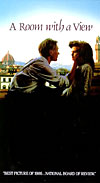 The
Bostonians (1984), another Henry James' adaptation, with an Oscar-nominated
performance from Vanessa Redgrave The
Bostonians (1984), another Henry James' adaptation, with an Oscar-nominated
performance from Vanessa Redgrave- A Room with a View (1985), a delightful comedy
of errors tale and social satire of repressed Victorian romance and
British conceit
- an adaptation from E.M. Forster's 1908 novel that was nominated
for eight Academy Awards (and won for Best Adapted Screenplay)
- Maurice (1987), the team's second E.M. Forster adaptation
- Mr. and Mrs. Bridge (1990)
- the Best Director-nominated Howard's End (1992),
the third Forster adaptation with another Best Adapted Screenplay Oscar,
with award-winning Emma Thompson, Anthony Hopkins, and Vanessa Redgrave
- the critically-acclaimed The Remains of the Day (1993),
adapted from Kazuo Ishiguro's novel, with Anthony Hopkins as an emotionally-crippled
butler
- Jefferson in Paris (1995), about the public and
private life of the US President (Nick Nolte)
- Surviving Picasso (1996), another semi-biographical
epic of the famous painter
Other Great Epics:
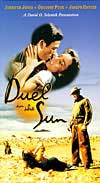 The
greatest Civil War film and the most definitive of all epics was also a Southern
costume drama - David O. Selznick's sweeping production of Gone With
The Wind (1939). In his later years, cinematic pioneer King Vidor
directed the lusty Western epic Duel in the Sun (1946) with Lionel Barrymore as the sprawling land baron. The all-star, panoramic Cinerama film, How the West Was Won (1962), was another example
of a western epic. Costner's Best Picture-winning revisionist epic western Dances with Wolves (1990) was the first Western to win the top
honor since Cimarron (1930). The
greatest Civil War film and the most definitive of all epics was also a Southern
costume drama - David O. Selznick's sweeping production of Gone With
The Wind (1939). In his later years, cinematic pioneer King Vidor
directed the lusty Western epic Duel in the Sun (1946) with Lionel Barrymore as the sprawling land baron. The all-star, panoramic Cinerama film, How the West Was Won (1962), was another example
of a western epic. Costner's Best Picture-winning revisionist epic western Dances with Wolves (1990) was the first Western to win the top
honor since Cimarron (1930).
Other notable war-time epics have been produced, including
the re-creation of D-Day in Darryl F. Zanuck's The Longest Day (1962),
the WWII hero adventure PT 109 (1963) about John F. Kennedy's (Cliff
Robertson) courageous rescue of fellow Marines, the big-screen epic biography Patton (1970), Joseph Sargent's MacArthur
(1977) about the rebellious, showy WWII general portrayed by Gregory Peck,
and the recent recreation of the Nazi Holocaust in Best Director and Best
Picture-winning Steven Spielberg's Schindler's List (1993). Also Mel Gibson's Best Director and Best
Picture-winning Braveheart (1995) brought the 13th century story of
medieval Scottish patriot William Wallace's rebellion against the British
to the big screen. Spielberg's epic war film, Saving Private Ryan (1998) opened with a bloody account of the Normandy D-Day landing.
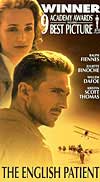 The
Best Picture winner of the mid-1980s, Sydney Pollack's Out of Africa (1985),
was about author Isak Dinesen (Meryl Streep) and her love affair with handsome
aviator Denys Finch-Hatton (Robert Redford). And into the 1990s, there were
these two Best Picture epic victors: The
Best Picture winner of the mid-1980s, Sydney Pollack's Out of Africa (1985),
was about author Isak Dinesen (Meryl Streep) and her love affair with handsome
aviator Denys Finch-Hatton (Robert Redford). And into the 1990s, there were
these two Best Picture epic victors:
- Anthony Minghella's adventure/war epic The English Patient
(1996) about Count Laszlo Almasy (Ralph Fiennes) - a burned WWII pilot
and his tragic love affair with a married Englishwoman (Kristin Scott Thomas)
- James Cameron's $285 million big-budget romantic/historical
epic Titanic (1997), a blockbuster recreation of the fateful first/last
voyage of the R.M.S. Titanic in 1912 told alongside an ill-advised
romance between a steerage passenger (Leonard DiCaprio) and a society debutante
(Kate Winslet) - its 11 Oscars tied the all-time record with Ben-Hur (1959)
Historical Epic Dramas from Literary Works:
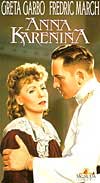 Literary
adaptations of novels and plays have provided the plots and storylines of
hundreds of historical dramas. There have been numerous screen versions of
Russian writer Leo Tolstoy's work, Anna Karenina. The first was the
classic 1935 film starring Greta Garbo and Fredric March, and then it was
filmed in 1948 with Vivien Leigh in the title role. Similarly, Tolstoy's epic
melodramatic novel War and Peace (1956) (with a final running time
of 208 minutes), with impressive battle scenes (especially the Battle of Borodino)
and panoramas, was brought to the screen by director King Vidor in the mid-50s.
It starred Audrey Hepburn as Natasha, Herbert Lom as Napoleon, Oscar Homolka
as General Kutzov, and Henry Fonda as Pierre. A Soviet version of War and
Peace (1963-1968) by director Sergei Bondarchuk was more faithful to the
book at 373 minutes in length, and took five years to complete. Literary
adaptations of novels and plays have provided the plots and storylines of
hundreds of historical dramas. There have been numerous screen versions of
Russian writer Leo Tolstoy's work, Anna Karenina. The first was the
classic 1935 film starring Greta Garbo and Fredric March, and then it was
filmed in 1948 with Vivien Leigh in the title role. Similarly, Tolstoy's epic
melodramatic novel War and Peace (1956) (with a final running time
of 208 minutes), with impressive battle scenes (especially the Battle of Borodino)
and panoramas, was brought to the screen by director King Vidor in the mid-50s.
It starred Audrey Hepburn as Natasha, Herbert Lom as Napoleon, Oscar Homolka
as General Kutzov, and Henry Fonda as Pierre. A Soviet version of War and
Peace (1963-1968) by director Sergei Bondarchuk was more faithful to the
book at 373 minutes in length, and took five years to complete.
Some other prominent examples include Louisa May Alcott's Little
Women (1933, 1994), Charles Dickens' David Copperfield (1935),
Anthony Hope's Prisoner of Zenda (1937), Emily Bronte's Wuthering
Heights (1939), Jane Austen's Pride and Prejudice
(1940), Daphne Du Maurier's Rebecca (1940), Charlotte Bronte's
Jane Eyre (1934) and Jane
Eyre (1943), Charles Dickens' Great Expectations (1946),
director King Vidor's film adaptation of the Ayn Rand novel The
Fountainhead (1949), Thomas Hardy's Tess (1979), Charles
Dickens' Little
Dorrit (1987), Edith Wharton's novel for Martin Scorsese's The
Age of Innocence (1993) about 19th century New York society,
and Henry James' early 20th century novel for Ian Softley's UK film The
Wings of the Dove (1994) with Helena Bonham Carter.
Major Epics in the New Decade:
New Zealander Peter Jackson's trilogy of author J.R.R.
Tolkien's best-selling fantasy, The
Lord of the Rings (2001-2003) was told on
a mammoth, epic scale. Ridley Scott's R-rated Best Picture winner Gladiator
(2000) (with state-of-the-art CGI visual effects) grossed $458 million
worldwide, won five Oscars, and inspired a new wave of other shield-clanging
'sword and sandal' epics in the next decade. It unleashed Russell
Crowe as Maximus, a general who was turned into a slave and fought in
the Roman Coliseum to preserve his honor ("Are you not entertained?")
and attempt to overthrow the Emperor (Joaquin Phoenix).
A muscle-bound Brad Pitt starred as Greek hero/warrior
Achilles in Wolfgang Petersen's Troy (2004), loosely based on
Homer's 2,800 year-old epic poem The Iliad about the 10 year
war between Troy (headed by King Priam (Peter O'Toole)) and Greece,
and a blonde Colin Farrell and Angelina Jolie (as Alexander the Great's
mother Olympias) starred in Oliver Stone's much-criticized box-office
epic disaster Alexander (2004).
Ridley Scott's extravagant, beautifully filmed and fictionalized Kingdom
of Heaven (2005) told about the 12th century Crusades, while
Warners'/director Zack Snyder's bloody, CG-enhanced 300 (2006) was
based on Frank Miller's vividly graphic novel that retold the story
about the famous last stand in the Battle of Thermopylae in 480 B.C.
(an underdog Spartan army of 300 led by King Leonidas (Gerard Butler)
fought in phalanx formation against King Xerxes' Persian army of
250,000). [The notorious Alamo-style battle was also the subject
of The 300 Spartans (1962).]
Director Louis Leterrier's 3-D remake action film Clash
of the Titans (2010) featured
Gorgons, gods, and giant scorpions, and starred Sam Worthington (in
his followup film to Avatar (2009)) as Perseus - the mortal
son of the god Zeus (Liam Neeson), with the promised sequel Wrath
of the Titans (2012). The videogame adaptation Prince of
Persia: The Sands of Time (2010) by director Mike Newell, with
Jake Gyllenhaal as young fugitive prince Dastan, was a major PG-rated
flop for Disney Studios. Also, Tarsem Singh's $75 million action 3-D
epic
Immortals (2011) appeared to do well, with its story of secretly-chosen
Theseus (Henry Cavill), with the help of visionary priestess Phaedra
(Freida Pinto), battling ruthless King Hyperion (Mickey Rourke).
In 2003, Peter
Weir's Master
and Commander: The Far Side of the World (2003) was a swashbuckling
epic tale about a chase between a French vessel and a British frigate
(commanded by Capt. Jack Aubrey (Russell Crowe)) during the Napoleonic
Wars.
|
